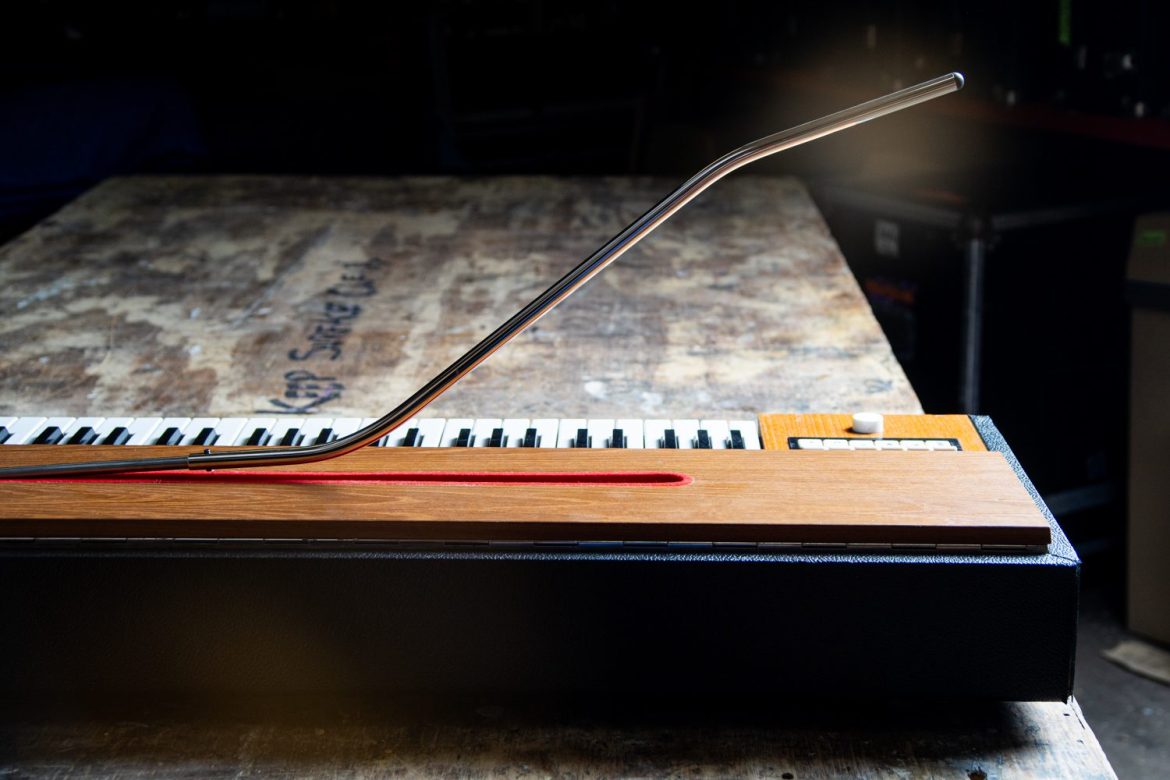
This one’s for the nerds! Here’s some info about what has gone into producing our new Clavinet Whammy Systems, and what sets them apart from their predecessors.
Order yours here!
How do you go about reverse engineering a system where almost nothing is straight? In short, a lot of precise measuring. Before any fabrication was done, hours were spent mapping each part of the Clavinet into 3D design programs. The compound angles of the whammy arm, both extending from the bridge and of the extension arm, are no simple feat of measurement.

checking angles on a whammy arm & bridge.
After measuring every element of the previous Clavinet whammy systems, design improvements and considerations began. Fortunately, over the years of installing heaps of former Clavinet whammy systems, we had already started to incorporate some innovations and improvements.
One of the first elements to consider beefing up was the stop arm, the guard which ensures a consistent return point for the whammy arm. Constant upward pressure from string tension tends to cause worn felt on the original stop arms. We took two measures to combat this, both widening the stop arm and using a special, very dense stop arm felt. The result is a better landing pad for the whammy arm after every bend, and one that will hold up against wear much longer.

A few of the raw components that make up the Whammy System.
Previous whammy systems ask a lot of the whammy arm’s connection joint. Because the lid route is the only point of “lost motion” prevention, a lot of forward/backward tension gets put onto the pin that connects the two sections of the whammy arm. Of course, this will begin to bore out after dozens of hours of use, similar to “keyholing” on a vintage cymbal.
A simple but highly effective system modification does a lot to solve this “keyholing” problem. With the use of an internal support block, our systems have drastically limited the “lost motion”, or back and forth motion of the whammy arm. Besides that, we tightened the tolerance of the arm connection joint significantly. This works in two directions, both helping to alleviate lost motion, and preventing joint wear by minimizing arm movement within the joint itself. The result is a whammy arm which feels, and indeed is, much less floppy than previous systems.
Even with our internal supports, the lid route is still an important section of the whammy system. There’s no way to get around that the whammy arm will always be making contact with some part of that lid route felt strip. We’ve seen a lot of older whammy kits with heavily worn lid route felt. A properly routed lid should allow for felt to hug the whammy arm, poorly routed lids allow excess motion. To ensure that ours won’t fray and wear out, we’ve sourced a specialized, super dense felt for the lid route, ensuring a strong support to hug around the whammy arm while in motion.
Getting into some of the fabrication improvements; Let’s talk about the whammy arm to bridge connection. We’ve actually seen previous systems snap and break here. Previous systems welded the arm to its bridge attachment piece with a simple welded butt joint. Our system is actually bored out then welded, providing a vastly more secure and reinforced connection between the bridge and whammy arm.

A previous whammy system (left), and a Chicago Electric Piano Whammy System (right).

welding a bridge connection on a whammy arm
One of the most complex fabrication elements is production of the whammy bridge. Absolute uniformity is a must, but precise drilling into a round piece of steel is not easy. Tensioned pins ensure a snug string post for each note of the Clavinet, but great care (and great jig making) must be taken to ensure the each bridge is absolutely perfect. This takes machine operating skill, and a lot of patience.

A whammy bridge, drilled and ready for pin installation.
These new whammy systems are chrome-plated right here in Chicagoland. Even the plating thickness has been considered to allow a more snug fit between the whammy arm sections, which just goes to show the precision with which we’re working. Thanks for reading a bit about how “the sausage is made” with our “Windy City Whammy”. We’re happy to answer any additional questions at info@chicagoelectricpiano.com
The Chicago Electric Piano Clavinet Whammy System is the next generation of Whammy Clavinets, built more robustly and operates more smoothly than any whammy before. Pre-order your “Windy City Whammy” below! Orders received before July 4th receive a 10% discount off retail.
Order yours here!

